Since Time is Money, Metro Wants a Business Partner to Help Metrobus Go More and Stop Less
Metro is exploring opportunities to partner with a private company or investor to pilot off-board SmarTrip® loading to help improve customer travel times and lower our operating costs.
Metrobus speeds have steadily decreased over time as the region grew and traffic worsened. This not only negatively impacts Metro customers, but also increases our operating costs. As traffic congestion erodes bus speeds, we need to deploy more vehicles and operators on the busiest routes in order to maintain service frequencies. We know that behind the statistics stand legions of bus riders who want faster service, as well as counties and cities that want lower bills for that service.
Off-Board Fare Payment and Transit Prioritization
There is no silver bullet to speed up transit. Instead, agencies can use a combination of technology and on-street treatments to increase bus speeds and move more passengers. One of the few prioritization strategies Metro can undertake on its own is allowing off-board fare loading, moving all SmarTrip® value loading from the farebox to kiosks near bus stops. This would reduce the amount of time it takes for passengers to board buses and pay fares, in turn speeding up bus trips. We have looked into this in the past and have recently revisited this important concept.
Research and field surveys show that bus dwell times at stops take up a significant portion of in-service time, and that cash transactions are a huge component of that dwell time. On the Metrobus system the average SmarTrip® rider takes approximately 2.5 seconds to board and tap on; cash fares take about 6 seconds; and card value loading takes around 20 seconds per customer. When those transactions are multiplied across stops and trips on busy routes like the 16th Street S-lines, we see dwell times eating up around 20% of total in-service time. Moving those transactions off buses will speed transit travel throughout the corridor.
How It Would Work
Most customers already ride Metrobus by quickly tapping their SmarTrip® card at the farebox, but many still pay with cash. Under this pilot program, customers boarding at stops with kiosks would load value at the kiosks before the bus arrives and boarding would be limited to SmarTrip® taps. We intend to explore small kiosks that take up no more than 2.5 square feet of sidewalk space and hopefully can run on solar power.
We know a shift to off-board fare payment would be a major change for Metro’s business model and our customers, so we are not advocating doing it system-wide or all at once. Instead, we think there’s value in starting with a pilot test program focused on five of the busiest Metrobus corridors, which together carry nearly 100,000 riders per day:
- 14th Street (52, 53, 54)
- 16th Street (S1, S2, S4, S9)
- H Street/Benning Road (X2, X9)
- Georgia Avenue/7th Street (70, 74, 79)
- Wisconsin/Pennsylvania Avenues (30N, 30S, 31, 32, 33, 34, 36)
Boardings and demand do not warrant a kiosk at every bus stop, so for this pilot we propose an average of 50 kiosks per corridor. These would be located at high-ridership stops and/or areas underserved by retail and other services. Additionally, we’re also seeking to expand the places where riders can purchase SmarTrip® cards and load value – places like CVS, Walmart, Giant, and other third-party retailers.
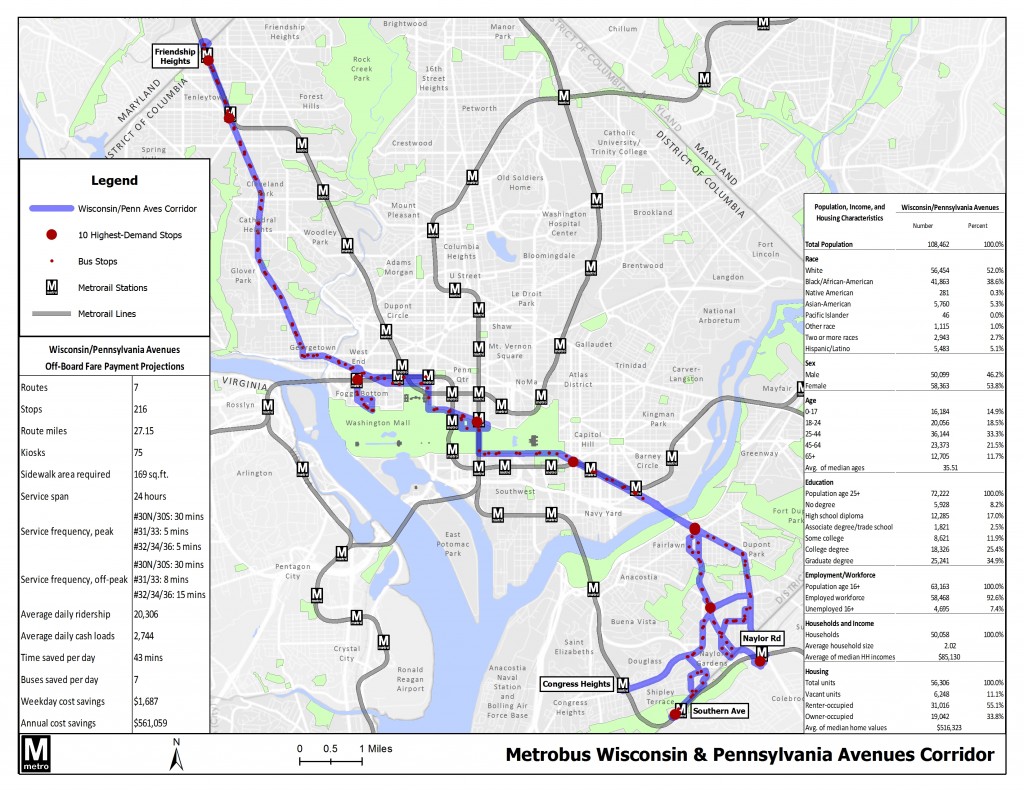
10 highest volume stops on the Wisconsin/Pennsylvania Avenues corridor, likely candidates for off-board loading kiosks.
Benefits and Costs
Based on an initial pilot of around 50 kiosks per corridor or 260 total; the purchase, installation, and licensing of software; and the costs and permitting for sidewalk space, the total up-front capital cost is about $11.2 million for all five corridors. The costs of operating the kiosk system would add around $320,000 per year, subject to rise with inflation. However, the financial benefits are extensive and soon outpace the up-front costs. Our analysis shows a total savings of 240 service minutes per day across all five corridors. This means not only faster trips for riders, but lower costs for Metro as we could use 33 fewer bus-hours daily to provide the same frequencies. The results indicate a total operating cost savings of approximately $2.63 million per year.
In addition to these quantified benefits for Metro and our customers, we could use a successful example of off-board fare payment – one of the few bus prioritization strategies within Metro’s power – to leverage support from partner jurisdictions and taxpayers for larger and even more effective prioritization strategies on these busy corridors.
Business Arrangement
Given the results of this study, there is a business case for public-private investment (PDF) to support this pilot. Either the private company or investor would be responsible for all the up-front costs of buying and installing the kiosks and software; making sure it works seamlessly with Metro’s SmarTrip® system; and covering the costs of operating the kiosks and software, either in perpetuity or at a predetermined date when Metro would take over ownership. In return for that up-front investment, Metro would guarantee repayment from the operating cost savings generated by off-board fare payment. We project that cumulative cost savings would outpace cumulative investor outlays within five to seven years of operations.
Most readers of this blog know that grants and other capital funding for new infrastructure and services are scarce and incredibly competitive. Solid, transparent public-private partnerships can be an effective way for a public agency to implement improvements in an era of constrained resources. This business plan appears to be a win-win-win situation for Metro, our customers, and the investor. Now we just need to find one!
Do you think this sounds like a reasonable and responsible approach? Do you think this appears to be a rational cost-benefit analysis? How would you feel about taking all cash transactions off-board, provided there are either kiosks or a SmarTrip® retailer within easy walking distance of any bus stop?

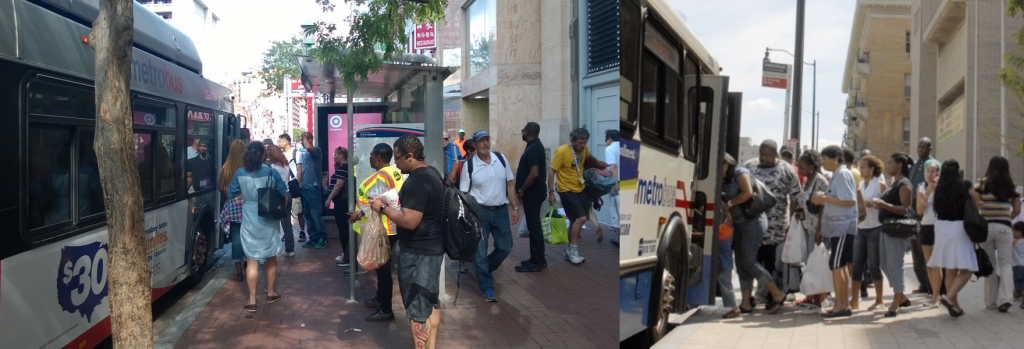
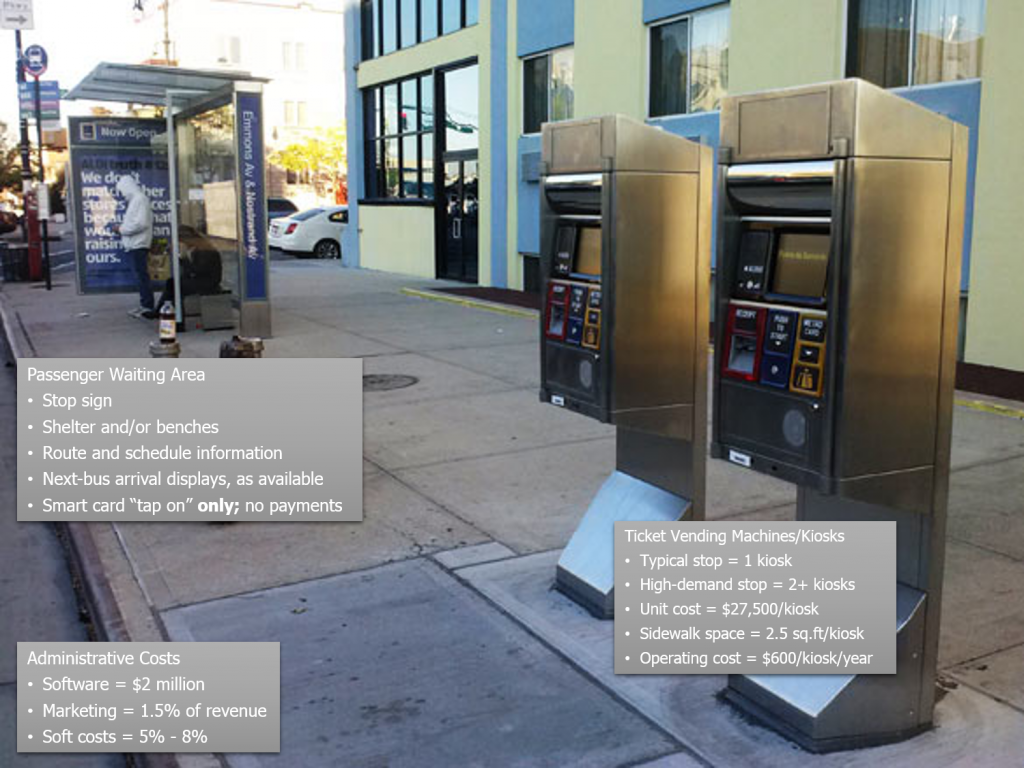
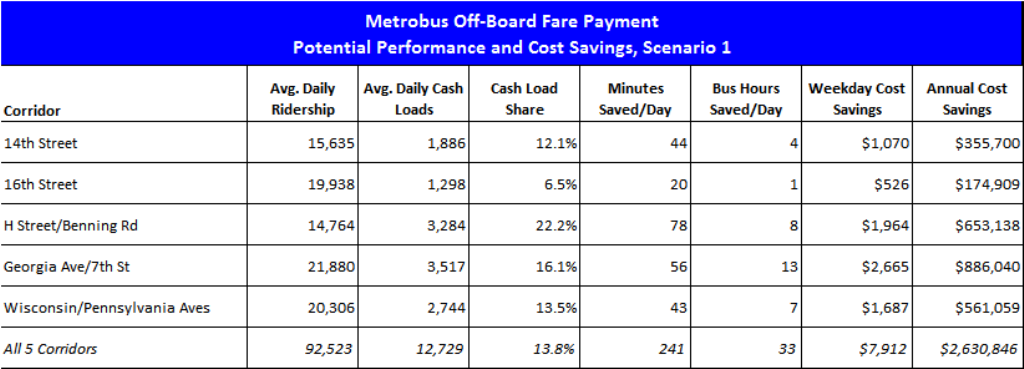
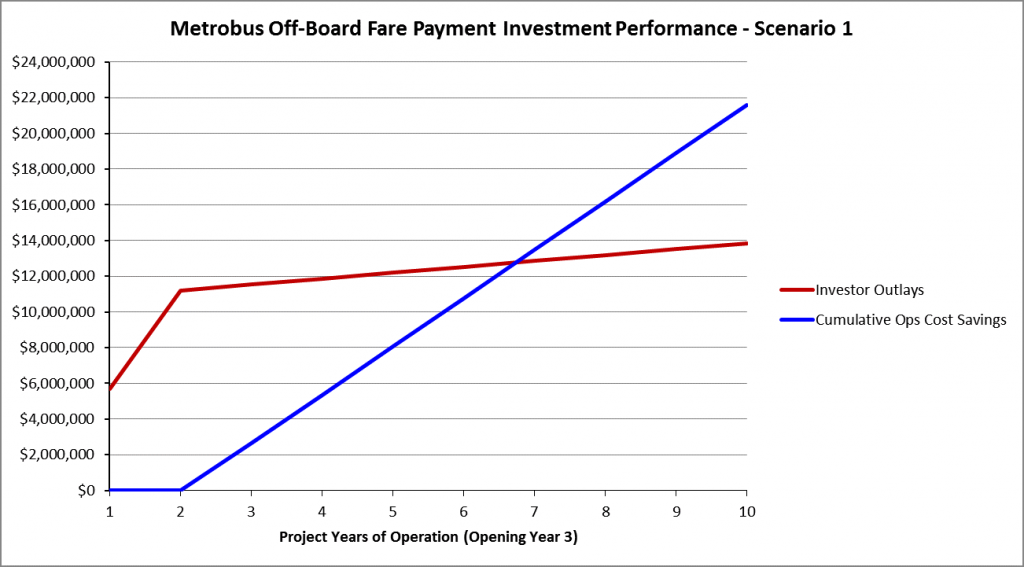


This sounds like a good plan. Transit serves everyone, including the businesses in these busy corridors. Their employees and customers are arriving by transit, or they benefit by transit taking cars off the road. Many areas require developers to invest in road improvements when they create new demand; I think it is long past time that this model is applied to transit as well.
My only concern is that this kind of plan would necessarily focus on well-developed areas with businesses and organizations wealthy enough to enter into partnerships, but transit improvements can’t be restricted just to such areas. They need to serve everyone, regardless of income.
Overall I think it’s a good idea, but the devil is in the details. Mark, how has NYC’s experience been with a similar program? Are there other programs out there that demonstrate what works/doesn’t work?
I’m unsure about having “SmarTrip tap-only” stops. That would essentially close the stop to anybody who doesn’t already have a SmarTrip card, unless these machines also dispense cards.
For those who run to catch the bus but their card is empty, it’s not fair to the other riders to have the bus wait while the reload was done on the curb, but it’s not fair for the rider to miss the bus who would otherwise be allowed to reload on board.
If bus riders always used the rear door to exit the bus, that would be a time saver at busy stops for basically no cost.
So, this is just silly. Why are you even allowed to add money on the bus? We would never put ATMs on buses so those with cash could withdraw money if they didn’t have enough. Similarly, we wouldn’t think of putting ATMs at bus stops. They’re already in lots of convenient places, and so we expect people to arrive at the bus stop with enough cash. Why not just do similar things with SmartTrip machines? Make them more ubiquitous around the district (in most grocery stores and drug stores), and you don’t need to come up with silly solutions like adding money on the bus or putting them at stops.